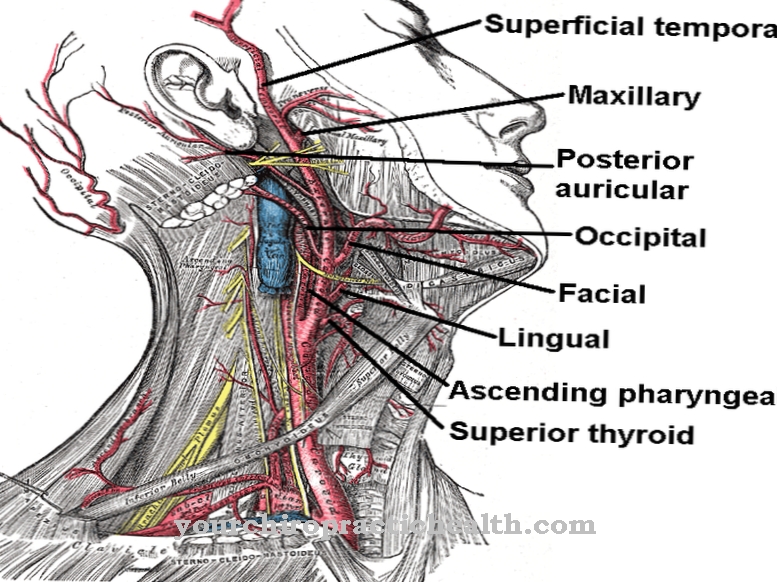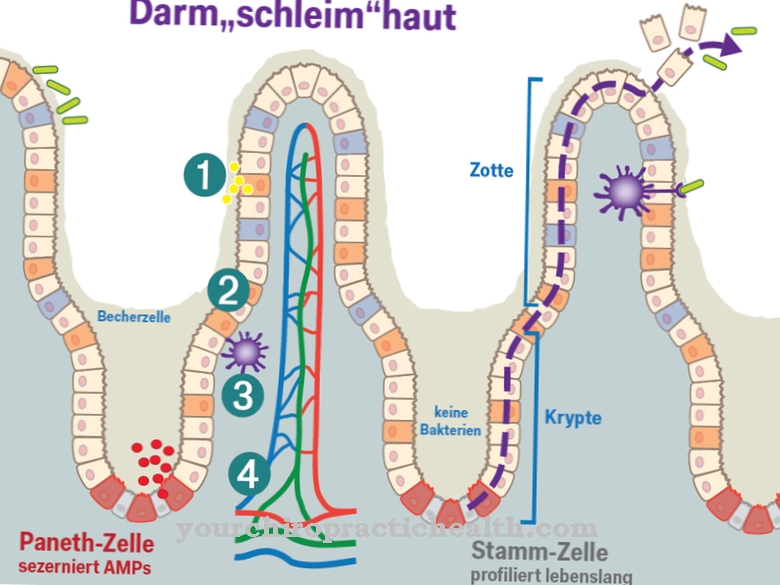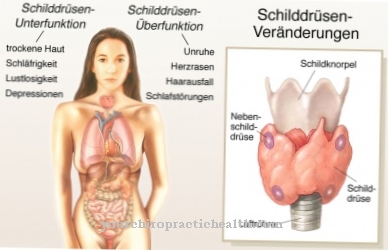Of the Pulmonary trunk is a short arterial vessel that, as a common trunk, forms the connection between the right ventricle and the right and left pulmonary arteries, into which the pulmonary trunk branches. The pulmonary valve is located in the entrance area of the artery and closes during the relaxation phase of the chambers (diastole) in order to prevent the blood from flowing back from the pulmonary arteries into the right ventricle.
What is the pulmonary trunk?
The pulmonary trunk forms the common trunk of the right and left pulmonary arteries (arteria pulmonalis dextra and sinistra) into which the Arterial trunk already branched after a course of about 5 centimeters. The pulmonary trunk, together with the two pulmonary arteries, represents the arterial part of the pulmonary circulation.
In the arterial part of the pulmonary circulation, "used", oxygen-poor and carbon dioxide-rich blood, which reaches the right ventricle from the great body circulation, is transported into the two lungs. This is where the further branches of the two pulmonary arteries take place down to the capillary level. The capillaries enclose the alveoli, where the exchange of substances takes place and the blood is enriched with oxygen.
The arterial part of the pulmonary circulation is the only arterial system in the body that carries deoxygenated blood. In the initial section of the pulmonary trunk is the pulmonary valve, which prevents the blood from flowing back from the pulmonary arteries into the right ventricle during the relaxation phase (diastole) of the chambers.
Anatomy & structure
The pulmonary trunk begins in the wall of the right ventricle and branches into the left and right pulmonary arteries after about 5 cm. With its diameter of about 3 cm, it is one of the large vessels. A special feature is that the arterial trunk runs just below the aortic arch because the unborn child has a connection point at the point of contact between the two arteries, which short-circuits the pulmonary circulation because there is no lung breathing before birth.
In the case of arteries, a basic distinction is made between muscular and elastic types as well as mixed forms and, as a special type, blocking arteries, which can “close up” if necessary and completely interrupt the blood flow. While the arterial system of the great blood circulation or body circulation offers significantly more vascular resistance than that of the pulmonary circulation and the resistance to setting and changing the blood pressure must be variable, the arteries of the body circulation usually belong to the muscular types. The vascular resistance in the arterial part of the pulmonary circulation is only about a tenth of the resistance in the body circulation.
This and the fact that the blood flow in the alveoli has to be regulated "regionally" depending on the oxygen supply, the arterial trunk and the two pulmonary arteries should only react minimally to nerve stimuli and messenger substances that narrow the vessels (vasoconstriction). Hence, evolution has developed the pulmonary artery trunk and the two pulmonary arteries as elastic arteries. This means that the middle of three layers (tunica media) of its walls is weak and contains only a few muscle cells. On the other hand, elastic fibers predominate.
Function & tasks
As the trunk of the pulmonary arteries, the pulmonary trunk ensures the central supply of the arterial pulmonary circulation and is the counterpart to the central arterial supply of the body circulation through the aorta, from which all arteries of the body circulation branch off. Due to the central supply of the two blood circuits, the heart gets by with "only" four heart valves, two of which are designed as pocket valves and close the arterial outlets in the right and left chambers (pulmonary valve and aortic valve) during the relaxation phase of the chambers (diastole) and release during the tension and contraction phase.
The task of the pulmonary trunk is not only to function as a supply line for the pulmonary circulation, but also has the task of ensuring an almost continuous flow of blood to the alveoli of the lungs and maintaining a minimum pressure - especially during diastole . The arterial trunk and the two pulmonary arteries act as a kind of pressure reservoir, which at the same time has to protect the alveoli from pressure peaks and excessively fluctuating pressure curves during the two phases of the heart.
It is therefore important that the arterial trunk and the pulmonary arteries are designed as elastic arteries, which can inflate a little during the “pressure filling” through the right ventricle in order to absorb the pressure peak. The fulfillment of the task of functioning as a pressure accumulator during diastole requires the proper functioning of the pulmonary pocket valve in the entrance area of the pulmonary trunk.
Diseases
A functional restriction of the pulmonary artery trunk, which can be attributed to inflammations, infections or other diseases and the associated physiological changes in the vessel walls, is rare.
The development of a malfunction of the pulmonary valve in the entrance of the pulmonary trunk due to a stenosis or insufficiency due to diseases and inflammations is also relatively rare. Malformations and malpositions of the pulmonary trunk including the pocket valve are more common. Such malformations are usually accompanied by other congenital heart defects such as septal defects and others and lead to mild to severe effects and courses if they are not treated by corrective and reconstructive interventions.
Pathological vascular changes in the arterial part of the pulmonary circulation, which lead to a loss of elasticity of the vascular walls, can cause pulmonary hypertension (PH), which, depending on its severity, can lead to right heart strain and insufficiency. A very rare, congenital heart defect is the development of a common arterial trunk. In this case, the prenatal connection between the pulmonary trunk and the aorta to bypass the pulmonary circulation has not closed, so that oxygen-poor blood from the venous part of the body circulation (right chamber) mixes with oxygen-rich blood from the venous part of the pulmonary circulation with corresponding symptomatic consequences.













.jpg)

.jpg)
.jpg)











.jpg)